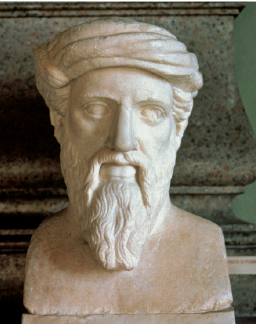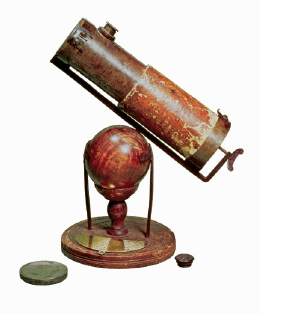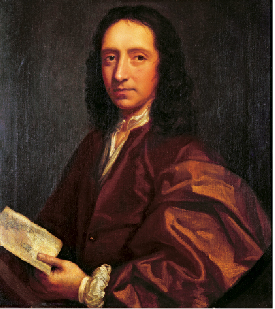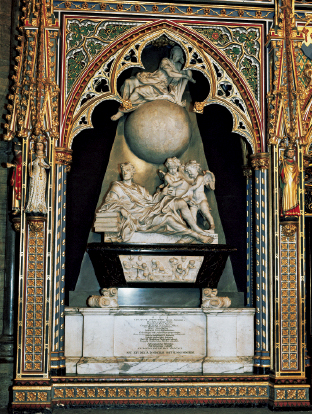Read The Clockwork Universe Online
Authors: Edward Dolnick
The Clockwork Universe (21 page)
Â
Â
The crucial belief of Isaac Newton and his fellow scientists was that God had designed the world on mathematical lines. All nature followed precise laws. The belief derived from the Greeks, who had been amazed to find that music and mathematics were deeply intertwined. Here they explore the relation between the weight of a bell, or the volume of a glass, and its pitch.
Â
Â
Pythagoras, shown below, is credited with being the first to find this connection, “one of the truly momentous discoveries in the history of mankind.”



Newton's theory of gravity propelled him to instant fame. He liked to tell the story, depicted in this Japanese print, that the crucial insight came from watching an apple fall. The story is quite likely a myth. Before anyone knew of his mathematical genius, Newton had dazzled the Royal Society with this compact yet powerful telescope.


Edmond Halley (known today for Halley's Comet) was a brilliant astronomer and, just as surprisingly, a man so congenial that he could get along with Isaac Newton. Halley took on the task of coaxing the reluctant, secretive Newton into publishing his masterpiece,
Principia Mathematica.
The 500-page book, in Latin and dense with mathematics, might never have appeared without Halley's labors.

Newton's tomb, in Westminster Abbey. From the moment he unveiled the theory of gravity Newton was hailed as almost superhuman. Voltaire observed Newton's funeral and was stunned to see dukes and earls carrying the casket. “I have seen a professor of mathematics, simply because he was great in his vocation, buried like a king who had been good to his subjects.”
The closer mathematicians looked at infinity, the stranger it seemed. Take one of the simplest drawings imaginable, a straight line one inch long. That line is made up of points, and there are infinitely many of them. Now draw a line two inches long. The longer line must have twice as many points as the shorter one (what else could make it twice as long?). But a matching technique, much like Galileo had used with numbers, shows that there are precisely the same number of points on both lines.

The proof is pictorial. Make a dot as in the drawing and draw a straight line from it through the two lines. Any such line pairs up a point on the short line with a point on the longer line. Like a perfectly orderly dance, everyone has a partner. No point on either line is left out, and no point has to share a partner with anyone else. How can that be?
Worse was to come. Exactly the same argument shows that a line ten inches long is made of precisely as many points as a line one inch long. So is a line ten miles long, or ten thousand. Could anything send a clearer message that infinity was a topic best left to philosophers and mathematicians, and completely unsuited to hardheaded scientists?
Infinity is built into mathematics from the beginning, because numbers go on forever. If someone made a claim about all the human beings on Earthâno person alive today is nine feet tallâin principle you could test it by gathering everyone into a line and working your way along from first person to last. But no such test can work for numbers, because the line never ends. For every number there is another, bigger number (and also another half as big).
But it was by no means clear that infinity had anything to do with the real world. That was fine. Seventeenth-century scientists, like all their predecessors, would happily have left the paradoxes of infinity to those who enjoyed such things. These practical men of science glanced at infinity, saw that it could not be tamed, and booted it out the door so that they could concentrate on the real-life questions that preoccupied them.
No sooner had they set to work than they heard a clawing at the window.
The most basic challenge in seventeenth-century science was to describe how objects move. To move is to change position. Infinity kept fighting its way into the picture because change comes in two forms. One is easy. The other would challenge and tantalize some of the most powerful thinkers the world had ever seen.
The easy form is steady change, as when a car rolls down the highway with the cruise control set at sixty miles an hour. The car is changing position, but one moment looks much like another. Now think of a rock falling off a cliff. The rock is changing position, like the car, but it is changing speed at every instant, too. That kind of
changing
change happens all around us. We see it when a population grows, or a bullet tears through the air, or an epidemic sweeps through a city. Something is changing, and the rate at which it is changing is changing, too.
Look again at the falling rock. Galileo showed that, as time passed, the rock fell faster and faster. At every instant its speed was different. But what did it mean to talk about speed at a given instant? As it turned out, that was where infinity came in. To answer even the most mundane questionâhow fast is a rock moving?âthese seventeenth-century scientists would have to grapple with the most abstract, highfalutin question imaginable: what is the nature of infinity?
It was easy to talk about
average
speed, which posed no abstruse riddles. If a traveler in a hackney coach covered a distance of ten miles in an hour, then his average speed was plainly ten miles per hour. But what about speed not over a long interval but at a specific moment? That was trouble. What if the horses pulling the coach labored up a steep hill and then sped down the far side and then stumbled and slowed for a moment and then regained their footing and sped back up? With the coach's speed varying unpredictably, how could you possibly know its speed at a precise instant, at, for instance, the moment it passed in front of the Fox and Hounds Tavern?
The point wasn't that anyone needed to know precisely how fast coaches traveled. For any practical question about making a journey from here to there, a rough guess would do. The coach's speed was only important as the key to a larger question: how could you devise a mathematical language that captured the ever-changing world and all its myriad moving parts? How could you see the world as God saw it?
Before you could tackle the world in general, then, it made sense to try to sort out something as familiar as a horse-drawn coach. For decades mathematicians had all tried to solve the mystery of instantaneous speed in the same way. Speed, they knew, was a measure of how much distance the coach covered in a given time. Suppose the coach happened to pass the Fox and Hounds at precisely noon. To get a rough guess of its speed at that moment, you might see how far down the road it was an hour later. If the coach had traveled eight miles between noon and one o'clock, its speed at noon was likely somewhere near eight miles per hour. But maybe not. An hour is a long while, and anything could have happened during that time. The horses might have stopped to graze the grass. They might have been stung by hornets and broken into a sprint. It would be better to guess the coach's speed at the stroke of noon by looking at how far it traveled in a shorter interval that included noon, such as from noon to 12:30. A shorter interval still, say from noon to 12:15, would be better yet. From noon to 12:01 would be even better, and from noon to one second after noon would be better than that.
Success seemed close enough to touch. To measure speed at the instant the clock struck noon, all you had to do was look at how much distance the coach covered in shorter and shorter intervals beginning at noon.
And then, with victory at hand, it flew out of reach. An instant, by definition, is briefer than the tiniest fraction of a second. How much distance did the coach cover in an instant? No distance at all, because it takes some amount of time to travel even the shortest distance. “Ten miles per hour” is a perfectly sensible speed. What could “zero distance in zero seconds” possibly mean?
